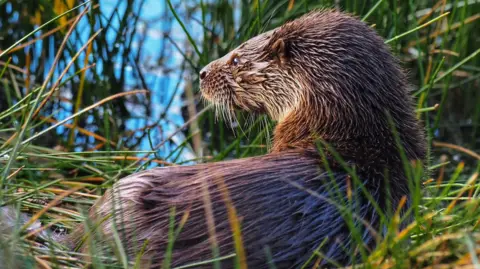'Otters chose to come here - now they're thriving'
 Tony Marshall/Leicestershire and Rutland Wildlife Trust
Tony Marshall/Leicestershire and Rutland Wildlife TrustMatt Scase says he is often asked when otters were introduced to Rutland Water Nature Reserve.
However, the nature lover, who works at the reservoir for the Leicestershire and Rutland Wildlife Trust, tells the BBC people are always surprised by the answer.
"We actually didn't introduce them - they chose to come here," he said.
"That's a good sign for us because they wouldn't have come unless we had a really good quality of water."
"Well, that and the fact we have a massive reservoir with loads of fish they can eat. That helps too," he added.
Mr Scase has spent recent weeks out and about on the reserve trying to capture footage of the mammals.
He said: "We describe them as elusive but it's actually getting much easier to spot them because they have been thriving here.
"We are not sure about the exact number [of otters] but we can see a mixture of male adults and females and cubs."
 Tony Marshall/Leicestershire and Rutland Wildlife Trust
Tony Marshall/Leicestershire and Rutland Wildlife TrustMr Scase added: "We have had a particular increase in numbers in the last few years.
"We know there is an increasing number of areas where they are nesting.
"They can mate all year round but usually they do so between October and November.
"That's why this can be a good time to see cubs playing around."
Otters: The facts
- Otters are a protected species in the UK under the Wildlife and Countryside Act 1981
- In the 1970s they were close to extinction in England, due to pollution and persecution, but have now made a comeback with populations growing across the country
- An otter can typically grow to 80cm (31.5in) in length and their average lifespan is five to 10 years
- They are one of the UK's top predators and feed mainly on fish
- Otters are well suited to a life in the water as they have webbed feet, dense fur to keep them warm, and can close their ears and nose when underwater
Source: The Wildlife Trusts
Follow BBC Leicester on Facebook, on X, or on Instagram. Send your story ideas to [email protected] or via WhatsApp on 0808 100 2210.
